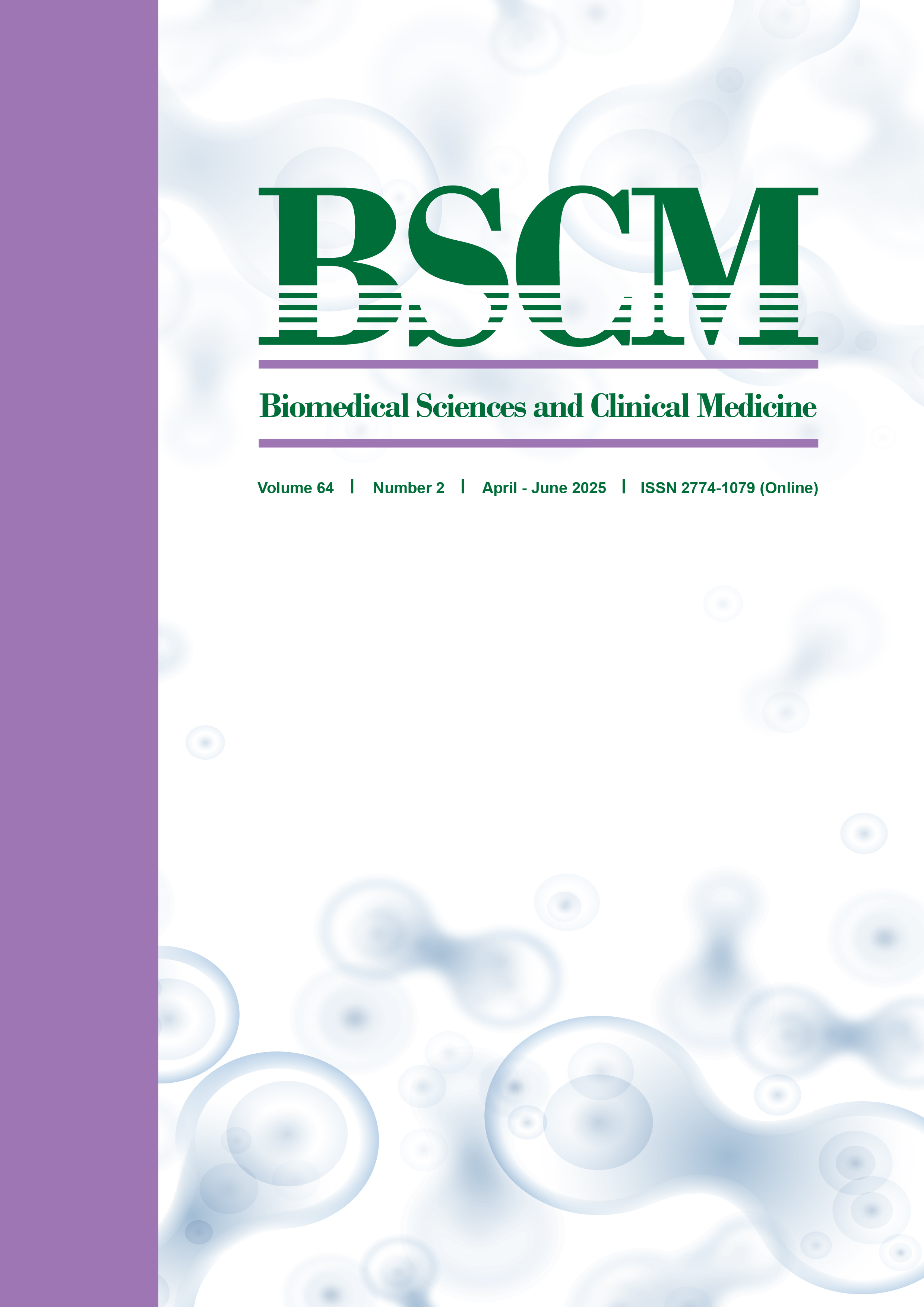Evaluation of Various Resolutions for Optimization and Dose Calculation in VOLOTM Ultra of the Tomo Therapy Treatment Planning System
Main Article Content
Abstract
Objective Helical tomotherapy can deliver a radiation dose using modulated intensity. This delivery technique requires inverse treatment planning for dose distribution. The specific parameters include the resolution of optimization and dose calculation. The highest resolution provided a high plan quality in a previous study, but that plan would increase the calculation time. This study investigated the quality of plans using various
resolutions of optimization and dose calculation in VOLOTM Ultra. The exploration aimed to determine the optimal resolution to inform the treatment planning process in nasopharyngeal carcinoma (NPC).
Methods Forty-one cases of NPC who had been previously treated using helical therapy were randomly recruited between January 2022 and December 2023. Nine treatment planning scenarios were created using the VOLOTM Ultra planning system using a combination of optimization and calculated resolution. Three different levels of resolutions were chosen: high (H), medium (M) and low (L). The different resolution combinations were expressed as, e.g., H/H for high resolution optimization and dose calculation. The dosimetric parameters of the planning target volumes (PTVs), organs at risk (OARs), and plan quality index, such as dose coverage (D98%, Dose at 98% target volume), conformity index (CI) and homogeneity index (HI), were evaluated.
Results The PTVs revealed an increasing dose value when the dose calculation resolution was increased. In contrast, the study found an increasing dose value when the resolution was decreased. A similar trend was also found in the conformity index value in the optimization process. The OARs demonstrated similar dose levels, with the exception of the spinalcord and both parotid glands.
Conclusions This study illustrates that the resolution of M/H and M/M scenarios is a specific choice of interest. These scenarios provide higher dose coverage, have a mild impact on OAR dose, a moderate impact on conformity and a shorter treatment planning time.
Article Details

This work is licensed under a Creative Commons Attribution 4.0 International License.
References
De Felice F, Cattaneo C, Franco P. Radiotherapy and Systemic Therapies: Focus on Head and Neck Cancer. Cancers (Basel). 2023;15:4232. PubMed PMID: 37686508
Taylor A, Powell M. Intensity-modulated radiotherapy--what is it? Cancer Imaging. 2004;4:68-73.
Chui C, Spirou S. Inverse planning algorithms for external beam radiation therapy. Med Dosim. 2001;26: 189-97.
Rong Y, Welsh J. Dosimetric and clinical review of helical tomotherapy. Expert Rev Anticancer Ther. 2011;11:309-20.
Kawashima M, Kawamura H, Onishi M, Takakusagi Y, Okonogi N, Okazaki A, et al. The impact of the grid size on tomotherapy for prostate cancer. J Med Phys. 2017;42:144-50.
Kim K, Chung J, Suh T, Kang S, Kang S, Eom K, et al. Dosimetric and radiobiological comparison in different dose calculation grid sizes between Acuros XB and anisotropic analytical algorithm for prostate VMAT. PLoS One. 2018;13:e0207232. PubMed PMID: 30419058
Park J, Kim S, Park H, Lee J, Kim Y, Suh T. Optimal set of grid size and angular increment for practical dose calculation using the dynamic conformal arc technique: a systematic evaluation of the dosimetric effects in lung stereotactic body radiation therapy. Radiat Oncol. 2014;9:5. PubMed PMID: 24387278
Snyder Karen C, Liu M, Zhao B, Huang Y, Ning W, Chetty I, et al. Investigating the dosimetric effects of grid size on dose calculation accuracy using volumetric modulated arc therapy in spine stereotactic radiosurgery. J Radiosurg SBRT. 2017;4:303-13.
Spirou S, Fournier-Bidoz N, Yang J, Chui C, Ling C. Smoothing intensity-modulated beam profiles to improve the efficiency of delivery. Med Phys. 2001;28: 2105-12.
Srivastava S, Cheng C, Das I. The dosimetric and radiobiological impact of calculation grid size on head and neck IMRT. Pract Radiat Oncol. 2017;7:209-17.
Yawichai K, Chitapanarux I, Wanwilairat S. Helical tomotherapy optimized planning parameters for nasopharyngeal cancer. Journal of Physics: Conference Series. 2016;694:012002.
Park J, Park S, Kim J, Carlson J, Kim J. The influence of the dose calculation resolution of VMAT plans on the calculated dose for eye lens and optic pathway. Australas Phys Eng Sci Med. 2017;40:209-17.
International Commission on Radiation Units and Measurements. J ICRU. 2014;14:Np.
Oelfke U, Bortfeld T. Inverse planning for photon and proton beams. Med Dosim. 2001;26:113-24.
Incorporated. A. Radixact Physics Essential Course Workbook 1058101.K2022.
Chow J, Jiang R. Dose-volume and radiobiological dependence on the calculation grid size in prostate VMAT planning. Med Dosim. 2018;43:383-9.


